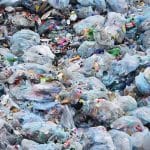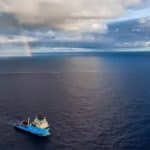Sophie Chapelle: When we think of plastic pollution, we visualize the seas of plastic described as the “seventh continent”. Why is there more danger in plastic that we cannot see?
Nathalie Gontard: The danger is very often equated with plastic waste large enough to be seen. Their consequences are not negligible – in quantity, they dry out the soil and suffocate species that ingest them. But plastic becomes truly dangerous when it is no longer visible, that is to say when it is fragmented into micro and nano-plastics. It then multiplies its interaction and nuisance properties. It has the capacity to transform and absorb essentially hydrophobic molecules, i.e. all pollutants (pesticides, etc.) present in the environment.
Micro and nano-plastics can transport these molecules – through water, air and land – and enter all the organs of living beings, passing biological barriers. We find them assimilated in the pancreas of shrimp, our blood, our lungs, our liver... everywhere!
However, no living being has the biological tools to digest this plastic, to degrade it completely. The result is an accumulation of foreign bodies which leads to biological, metabolic, etc. dysfunctions.
Is this wave of micro and nano-plastics ahead of us?
We have accumulated nine billion tons of plastics on Earth since the 1950s, some of which have already degraded into micro and nano-plastics but the vast majority of which are in the process of degrading, notably in our landfills, but not only that.
Because it is not only single-use plastics that pose a problem, but also those with long-term use, in construction or clothing for example. From the moment they are produced, plastics begin to wear out, degrade and produce harmful micro- and nano-plastics. Micro-plastics in Lake Geneva [50 tonnes accumulate there each year, editor's note] come from synthetic fiber clothing still in use and emitted during washing.
The micro plastics deep in the Arctic ice come from the wear and tear of buildings, insulated with plastics and still in use. Microplastics in the air mainly come from the wear and tear of tires and the roads we use. Plastic pollution is primarily that which we do not see and emitted during use.
The great wave of micro- and nano-plastics is coming. We talk about a “time bomb”. When we produce 1 kg of plastic today, it is future generations who will have to deal with all the micro and nano-plastics that will result.
To what extent has plastic invaded the agriculture and food sector?
Of all the plastics we use, 40% comes from the manufacturing, transport and packaging of our food, therefore agriculture and the agri-food industry. In this sector, the uses of plastic are sometimes very short, with a kind of excess in its use. We have come to the point of consuming food packaged in plastic when we absolutely don't need it! One of the objectives of the anti-waste law for a circular economy (in force since 2022) is precisely to eliminate all this unnecessary packaging, in particular plastic packaging for fresh fruit and vegetables. But industrial lobbies are seeking to delay the implementation of these measures.
What is your view on so-called biodegradable plastic mulch films developed since the 2000s, particularly in vegetable crops and corn?
In agriculture, as in all other areas, new technologies are being developed with a lot of plastic. For example, we use plastics to be placed on the ground to limit the use of pesticides or watering, we cultivate in greenhouses to increase productivity... They are presented as ecological transition technologies. This is true to the extent that they reduce our carbon footprint.
On the other hand, they increase our plastic footprint – that is to say its capacity to last for thousands of years in the form of micro and nano-plastic. The plastic footprint is not taken into account in life cycle analyses. This is why certain strategies are entirely based on recycling, even though plastic recycling does not exist!
Can plastic be biodegradable?
This restoration project has recently taken another important step. According to a message posted on Twitter, the non-profit organization has removed up to 200 kilograms of plastic debris from the North Pacific Ocean. This area, known as the Great Pacific Garbage Patch (GPGP), is located between California and Hawaii.
This feat was accomplished on Trip 13, during the first cleanup deployment of 2023.
In the first litter extraction campaign of the year, the organization was able to extract 6 kilograms of litter from a large pile of floating plastics, which included everything from large fishing nets to tiny microplastics. According to a study, more than 260% of the litter plate consists of fishing-related plastic waste.
Waste removal was made possible by specially designed cleaning systems, called System 002, and other equipment. The system also includes cameras with artificial intelligence that continuously scan the surface of the ocean for plastic waste.
To collect waste, they use a long U-shaped barrier. To protect marine wildlife, the system moves slowly under the ocean and minimizes noise. Monitoring data provided by the company revealed a "low negative impact of System 002 on marine life during the first 12 trips".
But what happens once the waste is collected? The company responded in a post on Twitter: “We want to give new life to ocean plastic by working with partners to recycle it and turn it into sustainable plastic products. The organization launched “The Ocean Cleanup Sunglasses”, its first product made from plastic waste in October 2020.
Boyan Slat, a Dutch inventor, started this one-of-a-kind project in 2013. The North Pacific Ocean was chosen specifically because it receives a large amount of plastic waste from Asia, South America and from North America.
[INVESTIGATION 1/4]
December 2021, Saint-Chamas, on the edge of the Etang de Berre, north of Marseille. A gigantic metal hangar vomited molten waste in a terrible smell. Toxic fumes saturated the surrounding air. The levels of fine particles measured were "equivalent to those of Beijing", says Dominique Robin, general manager of AtmoSud, the air quality control body in the region. For nearly a month, the fire ravaged this warehouse filled to the roof with ordinary industrial waste, DIB in administrative jargon: cardboard packaging, plastic, scrap metal which companies are trying to get rid of, in return for finance. Recyclage Concept 13, the company that owns the hangar, held an authorization to store 1 cubic meters. On the spot, the firefighters discovered thirty times more…


 The great wave of micro and nano-plastics is coming
The great wave of micro and nano-plastics is coming
 Cleanup removes 200 kg of plastic from the Pacific Ocean
Cleanup removes 200 kg of plastic from the Pacific Ocean
 Landfills: a lucrative and highly polluting market
Landfills: a lucrative and highly polluting market